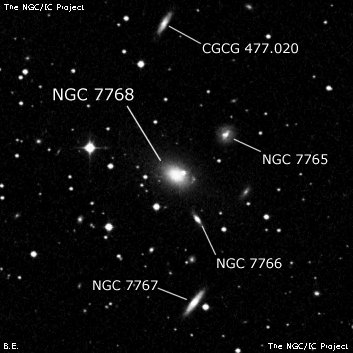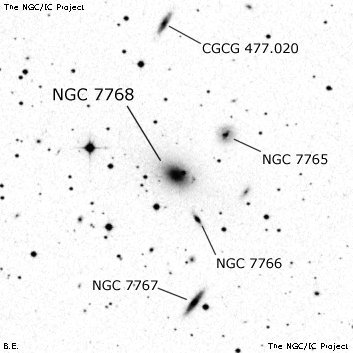NGC/IC Project Restoration Effort
(This is a very very beta version)
NGC7768


Basic Information
Location and Magnitude
Right Ascension: 23:50:58.4
Declination: +27:8:52
Constellation: PEG
Visual Magnitude: 12.3
Historic Information
Discoverer: Herschel J.
Year of discovery: 1828
Discovery aperture: 18.3
Observational
Summary description: vF, S, E, * inv, * p v nr
Sub-type: E2
Corwin's Notes
=====
NGC 7768 is the brightest of a group of galaxies found by Lord Rosse. His
diagram makes clear the identities of the objects he saw. Others in the group
are N7765, N7766, and N7767 (which see). Bigourdan's two "novae" here (IC
1511 and I1512, which see) are stars.
Steve's Notes
=====
NGC 7768
24" (8/5/13): the dominant galaxy in AGC 2666 appeared moderately bright, fairly small, elongated 3:2 WSW-ENE, 0.9'x0.6', contains a bright core with a very small brighter nucleus. A mag 13.5 star is superimposed west of the core, just 13" from the center. A mag 11 star (GR Peg) lies 2.6' ENE. NGC 7768 is surrounded by a number of faint galaxies including a N-S string of 4 galaxies to the north (with an additional 3 nearby). Another group of 3 or 4 galaxies (including NGC 7765, 7766, and 7767) are also arranged in a N-S string close west, so most of the cluster is in a 12' chain oriented north-south.
CGCG 477-020 is very faint, very thin edge-on 4:1 NW-SE, 24"x6". Located 4.3' N of NGC 7768 and southernmost in a string of four galaxies extending 4' N with PGC 72606 next at 1.3' N. PGC 62606 is extremely faint to very faint, very small, elongated 2:1 NW-SE, 15"x8". PGC 72608, just 1.1' further NNE, is very faint, very small, round, 12" diameter. Finally, PGC 72609, an additional 1.9' N, is very faint, very small, round, 12" diameter. CGCG 477-016, 3' due W of PGC 72609, is faint to fairly faint, fairly small, round, 24" diameter. Slightly larger and brighter than most members of the cluster. This is a rare collisional ring galaxy but was too faint to see any structure.
18" (8/26/06): by far the brightest member of AGC 2666. At 220x appeared moderately bright, fairly small, slightly elongated, ~1.0'x0.8', very small bright core. A mag 13.5 star is attached at the west edge. Located 2.5' WSW of mag 10.5 GR Pegasi. Several fainter NGC galaxies are strung out along a N-S line including NGC 7768.
CGCG 477-020, 4.3' N of NGC 7768, is extremely faint, small, elongated 2:1 in the direction of a mag 12 star 1.3' SE, 0.5'x0.25'. PGC 72608, 6.6' N of NGC 7768, is extremely faint and small, round, 15" diameter. PGC 72609, 8.5' due N of NGC 7768, is very faint, very small, round, 15" diameter. CGCG 477-016, just 3' to the west, is very faint, small, round, 25" diameter. Collinear with three mag 11-13 stars extending 9' to the SE.
17.5" (11/6/99): the brightest member of AGC 2666 is faint, small, round. A mag 14 star is attached at the west end of the halo. Appears slightly elongated WSW-ENE, 35"x25". Located 2.6' SW of mag 10.5-11.0 GR Peg. A mag 13 star lies 1.1' SE of center. The unusual collisional ring galaxy MCG +04-56-014 lies 9' N and a number of very faint NGC galaxies are nearby.
17.5" (7/20/90): fairly faint, small, round, fairly high surface brightness. A mag 13.5 star is at the west end 12" from the center. This is the brightest galaxy in AGC 2666 with NGC 7767 3.6' S, NGC 7765 1.7' NW, NGC 7766 1.4' SSW. Also MCG +04-56-019 lies 4.3' N (not seen). Located 2.6' WSW of a mag 10.5 star (GR Peg = 10.4-11.0).



